In an earlier post I was making a traditional charcoal kiln, but I also had a second oil drum, and today made that into a different kind of kiln I'd been told about.
Step 1: cut the top off an oil drum, and make slots in the side near the bottom (I did four, equally spaced):
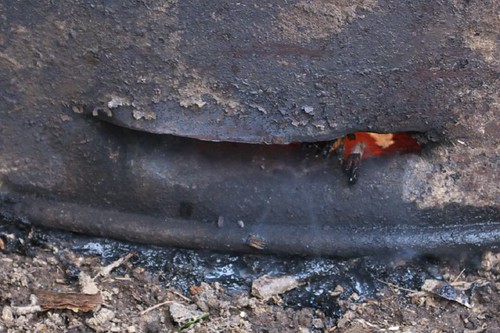 Step 2: burn out any remaining oil (this wasn't smoky this time, as there was plenty of air getting in through the slots at the base)
Step 2: burn out any remaining oil (this wasn't smoky this time, as there was plenty of air getting in through the slots at the base) Step 3: cut the top off a smaller drum, and pack it tightly with dry wood. I'm using a 20 litre veg oil drum for now, but I hope to get something larger, as I won't get an awful lot of charcoal out of this one:
Step 3: cut the top off a smaller drum, and pack it tightly with dry wood. I'm using a 20 litre veg oil drum for now, but I hope to get something larger, as I won't get an awful lot of charcoal out of this one:  Step 4: put the small drum inside the big one, open end down, and make a fire around it. You can see several "hot spots" from the air being drawn in rapidly through the slots:
Step 4: put the small drum inside the big one, open end down, and make a fire around it. You can see several "hot spots" from the air being drawn in rapidly through the slots: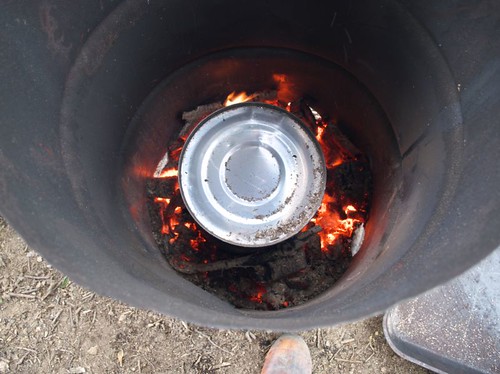 Step 5: Let it all cool down, and get your charcoal out of the small drum - I've not done this yet, it's cooling down right now, so I'll find out in the morning if it worked....
Step 5: Let it all cool down, and get your charcoal out of the small drum - I've not done this yet, it's cooling down right now, so I'll find out in the morning if it worked....
It should work better than a normal oil drum kiln (whole drum full of wood, lit and then sealed once the smoke turns blue), because the wood in the small drum will be heated and the volatile gases driven off, leaving the charcoal behind. There'll be no oxygen in the small drum, so the charcoal should not get burned up at all. Another advantage is that the fire in the larger drum can be made of twigs that aren't suitable for making charcoal, and the highly flammable volatiles driven off from the wood in the small drum will help feed the fire.
Tracy wasn't there with me today, so while the kiln was burning, I set about sharpening my chainsaw - this is much more pleasurable in the wood, rather than at the kitchen table! I mounted the saw on our chopping bock, using a neat little clamp: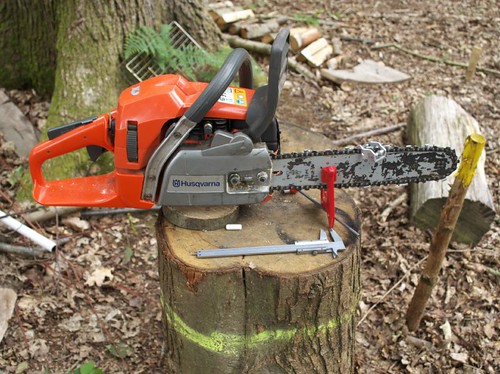
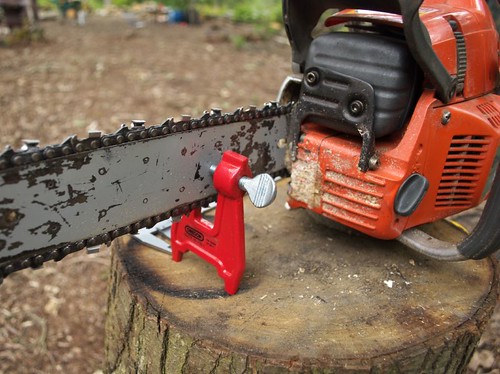 I also took the opportunity to tidy up the camp fire area, arranging the log benches and rebuilding the stove:
I also took the opportunity to tidy up the camp fire area, arranging the log benches and rebuilding the stove: I cleared an area for a tent too - I've got four mates visiting next weekend and we're going to camp there, hopefully cooking with my own sustainable produced charcoal!
I cleared an area for a tent too - I've got four mates visiting next weekend and we're going to camp there, hopefully cooking with my own sustainable produced charcoal!
And finally, here's some pictures of stuff that's growing. First, the biggest fungi I've seen in a long time. No idea what it is (so we won't be eating it...), but it was growing on the base of an ash tree in Sweep Wood: Then the pond, which is decidedly green:
Then the pond, which is decidedly green: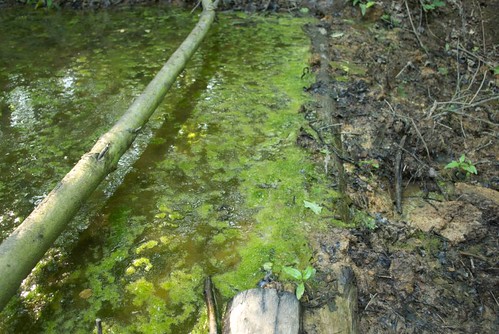 When you look closely, there are actually a lot of bubbles on the surface. Not sure if these are methane from decomposing matter in the pond, or oxygen from photosynthesis. Next time I'll take a match to find out! ;-)
When you look closely, there are actually a lot of bubbles on the surface. Not sure if these are methane from decomposing matter in the pond, or oxygen from photosynthesis. Next time I'll take a match to find out! ;-) 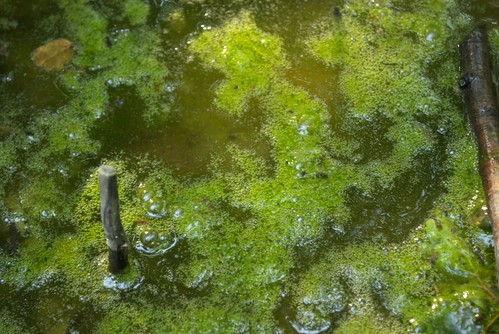 There's also a few random plants taking root on the banks of the pond - there's plenty of light there as we coppiced some of the nearby chestnut. We're really excited to see the pond slowly coming to life, as we have done absolutely nothing to introduce any species - this is all happening by itself.
There's also a few random plants taking root on the banks of the pond - there's plenty of light there as we coppiced some of the nearby chestnut. We're really excited to see the pond slowly coming to life, as we have done absolutely nothing to introduce any species - this is all happening by itself.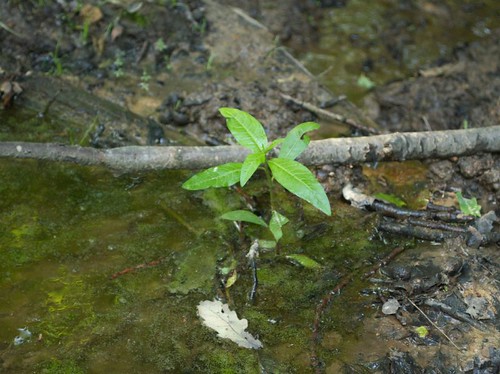 Out in the wayleave, beside our entrance, the grass seed we put down on the track is beginning to yield results:
Out in the wayleave, beside our entrance, the grass seed we put down on the track is beginning to yield results: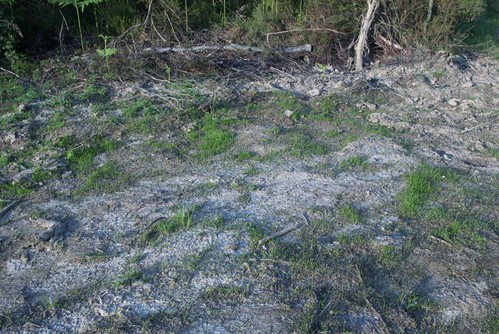 And in the wood, one of the oak stumps has decided to try and grow again. The only problem is that every single shoot is getting nibbled - I assume by rabbits or squirrels. Perhaps we could try using some closely spaced sticks to make a kind of fence to keep the rabbits off, though I'm not sure how well it would work...
And in the wood, one of the oak stumps has decided to try and grow again. The only problem is that every single shoot is getting nibbled - I assume by rabbits or squirrels. Perhaps we could try using some closely spaced sticks to make a kind of fence to keep the rabbits off, though I'm not sure how well it would work...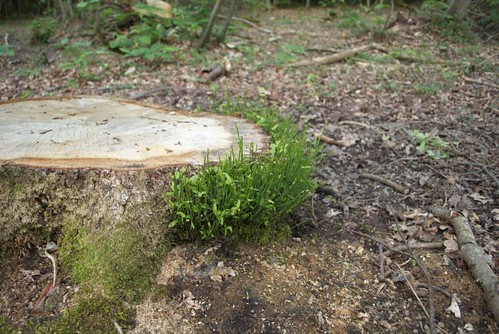 We're up again tomorrow, early in the morning, as we have some customers coming with a tractor and trailer to collect several tonnes of chestnut logs for using in their stoves - one of which is in a local pub.
We're up again tomorrow, early in the morning, as we have some customers coming with a tractor and trailer to collect several tonnes of chestnut logs for using in their stoves - one of which is in a local pub.
Mike
Saturday, 14 June 2008
Charcoal kiln test, and stuff that's growing
Subscribe to:
Post Comments (Atom)

4 comments:
Hello! Thanks for your visit. The fungus is Dryad's Saddle, Polyporus squamosus. It is a parasitic fungus (living on live wood) and degrades the heartwood of a tree. It is usually found higher up the stem but I have seen it several times at the base of ash trees in particular.
As it causes a white rot (degrades lignin in the wood). It is associated with pruning wounds and can be seen at multiple points on a tree where wounding through branch removal has occurred.
It can be tolerated by a tree for some years and may never result in failure, dependant of the trees defence success, however it seems to have degraded the heartwood of your ash tree to a larger extent.
I expect the tree will grow back as a coppice specimen and I would not expect the fungus to reinfect the tree as a coppice however if you let it develop into a larger specimen again it may become susceptible to infection.
Really like your blog by the way, I will be back!
Thanks for the feedback, good to get answers from someone who knows their stuff! :-) Mike
Hi Mike, I have just had a look at the tree after it failed and it looks like multi stemmed stump re-growth. Is there any signs of an ash tree degrading that these stems have regenerated from? It looks too small in the picture to have sucummed to Dryad's Saddle however if there was an ash tree there previously with the disease that would explain it. If there is an ash stump with the fungus in it beneath the fallen stems then it is likely to become infected again sooner. You can still coppice it however be aware that you may need to keep it cut more regularly.
Thanks for the update. It had certainly been coppiced before, probably a few times. We're intending to cut this part of the wood on a seven year cycle, so hopefully the fungus won't be an issue for us.
Cheers, Mike
Post a Comment